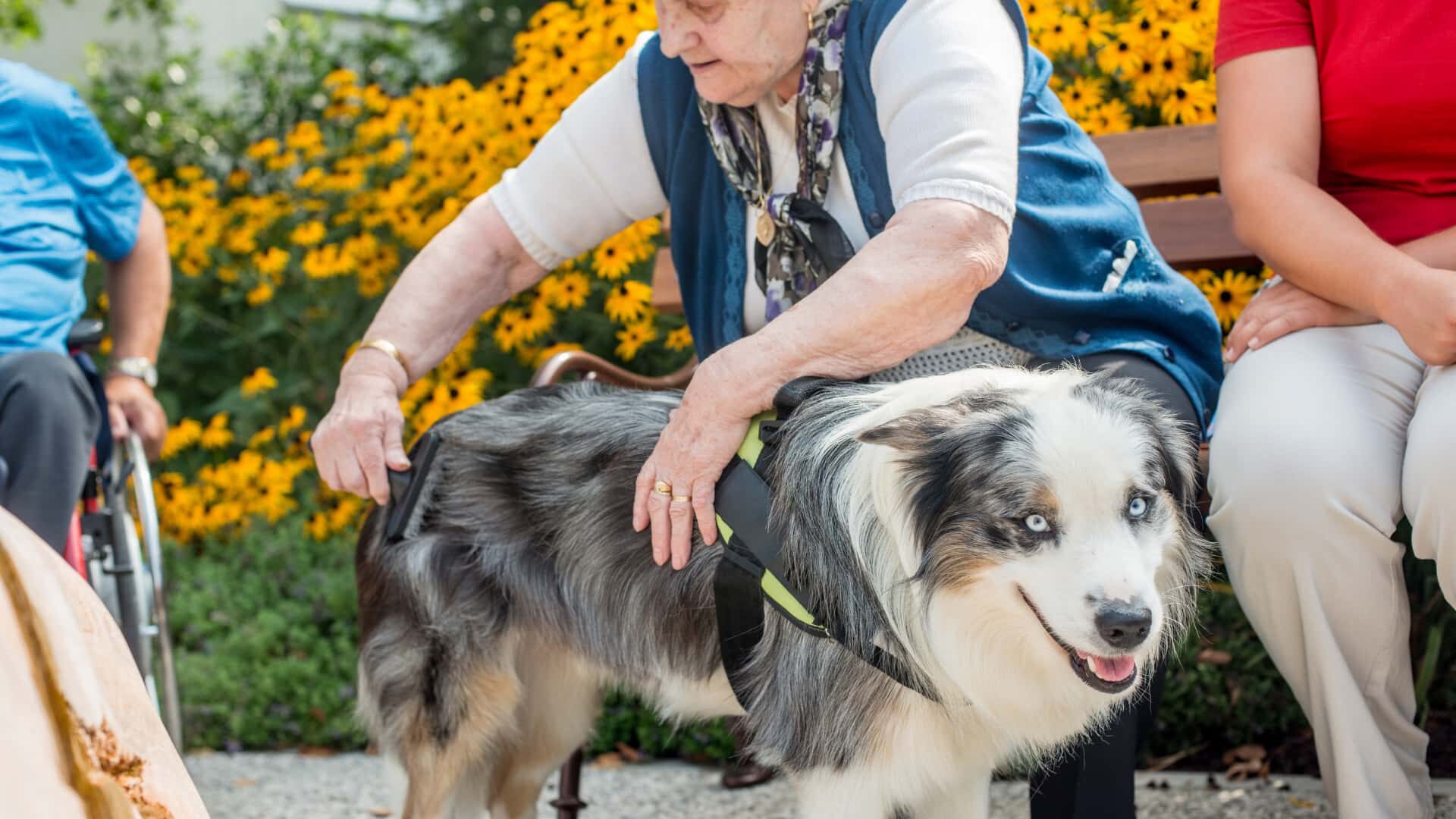You want to know what is an emotional support dog, right? Do you have a disability and need a dog that can help you become more independent?
Perhaps your parent’s health is failing, and they need a service dog while they live alone. You could be concerned about a co-worker with anxiety or depression and would like to find some ways to help them.
What is an emotional support dog?

Emotional support dogs (ESAs), sometimes known as emotional support animals (ESAs), must be prescribed by a certified mental health practitioner to a person with a debilitating mental condition in order to be legally recognized as such.
The presence of the animal must be determined by a therapist, psychologist, or psychiatrist to be beneficial to the patient’s mental health. Owning a pet, for example, may reduce stress or provide a sense of direction in one’s life.
Emotional support dog as service dog; what’s the difference?
Do you know someone who needs a puppy to help them deal with their grief? You might also look into the use of a service or therapy dog. Although the numerous terminology might be confusing, they aren’t interchangeable amongst the three categories.
Many dog owners claim that their pets alleviate their tension and anxiety, allowing them to carry out their daily routines more easily. The finest breeds for therapeutic work are widely debated, but the fact is that any type may be taught to do so.
Instead of concentrating on a certain breed, seek dogs who have the proper temperament for your family. There should be no aggression or aggression from service animals. Focus on how you feel when you’re among these adorable animals. As a first step, let’s go through each support animal and what they can do for you.
What are the benefits of emotional support dogs?
I have witnessed the many benefits of emotional support dogs. An emotional support dog can help with anxiety and depression, and it can also help with traumatic situations that someone may have gone through.
1. Involved in neurotransmitter synthesis
Numerous studies have shown the beneficial effects of canine neurotransmitters on human well-being. Dopamine is a brain neurotransmitter that is increased in dogs. Oxytocin is a neurochemical that is linked to feelings of love, attachment, and happiness. When pet owners gaze into the eyes of their pets, studies reveal that they experience feelings of love and joy.
Caring for another living being or a pet boosts your capacity for love and reduces your depression. Having a pet in the house might make a person who is lonely feel more secure and cared for. It’s no surprise that pet owners form close bonds with their animals because of their deep affection for them.
2. Plane anxiety is calmed by them
People with certain phobias, such as aerophobia, may benefit from ESAs (fear of flying in airplanes). Flying may be an agonizing experience for some individuals. Aerophobia is a legitimate medical condition, and it may be treated. So, several airlines now allow passengers to take their dogs along for the flight.
An emotional support animal may help alleviate some of the stress of flying. If you have aerophobia and are worried about flying, you could feel better if you cuddle or hug your pet. Consider taking an ESA with you if you are afraid of flying.
3. They offer unwavering support
Animals are capable of both receiving and giving affection. Animals, on the other hand, provide affection that can never be taken away. They provide unconditional affection that might be helpful to those who are experiencing a downturn in their mental health. After going through a period of emotional upheaval, these animals’ unconditional affection may help someone rediscover their sense of self-worth and confidence.
People’s mental health may improve drastically when they feel loved. This is essential for a person to re-engage with others, develop loving connections, and have more meaningful interactions with loved ones.
4. They may be used in conjunction with a variety of treatment modalities
There has been an increase in the use of emotional support animals by mental health counselors and therapists alike. It’s like telling people to do more exercise or eat healthier meals in order to manage their depression symptoms or prevent them from occurring in the first place.
5. They’re a source of social solace
In most homes, dogs and cats are considered part of the family. What is the reason behind this? Even being animals, they create a sense of community. Each person’s emotional and mental wellness needs a social partner.
It’s as though having an ESA around is like having a buddy while you’re living alone and feeling lonely. When you have an animal companion, such as a dog, you have the motivation to go out of the house and exercise. All of these things are beneficial to your mental health.
Can emotional support dogs really make a difference?
Yes, emotional support animals can make a big difference in the lives of their owners. The reason is that they are there to provide comfort and affection when the owner needs it most.
Some people have difficulty with social interaction, so having an animal around has been proven to help reduce their anxiety and stress levels. This is why many people with autism or PTSD find that having an emotional support dog can make all the difference in their lives.

As mentioned above, there are many benefits of having an emotional support dog. However, since they are not trained as service animals, they do not have any legal rights under federal law (the ADA). In cases where they are allowed on airplanes or in rent-controlled housing, this may change if the landlord’s insurance company will cover them (they often will).
Who can get an emotional support dog?
Emotional support dogs are allowed in many public places, including housing, hotels, and airlines. But they are not considered service animals and are not protected under the Americans with Disabilities Act.
People who are depressed or anxious may benefit from the company of an emotional support dog. Emotional support dogs are sometimes mistaken for service animals, which are trained to perform specific activities for individuals with disabilities. The canines that provide emotional support, on the other hand, are exempt from any kind of formal training or demonstration of particular abilities.
Emotional support animals are not covered under the ADA since they do not aid their owners in any way. Emotional support dogs are now allowed in certain businesses due to state legislation requiring landlords and company owners to comply.
Some states require documentation from a doctor stating that the person needs an emotional support animal. Other states don’t require this documentation but will ask for it if someone requests permission for an ESA in an apartment complex or other housing facility that does not allow pets on the premises.
Who can benefit most from emotional support dogs?
One of the primary reasons individuals seek out emotional support animals is the relief they get from having a pet around while they are experiencing distress. They help folks who are dealing with mental and emotional difficulties.
The presence of an animal for emotional support is recommended by therapists as well as psychiatrists when drugs are prescribed.
How to apply for an emotional support dog?

As difficult as life might be, it’s important to remember that you’re not alone in this. Many individuals turn to dogs as a source of comfort in order to deal with these sentiments. An ESD, on the other hand, is more than simply a regular pet.
It has been observed that the presence of a loving, dedicated dog may assist people with mental illnesses cope with the difficulties that occur from their condition.
In this post, we’ll explain what an Emotional Support Dog is, how you can get one, and how to “certify” an Emotional Support Dog. If you have a dog or cat, we’ll show you how to properly identify it as an ESD.
What makes a good emotional support dog breed?
Most people who suffer from some kind of mental disorder, experience depression, anxiety and panic attacks. Sometimes it helps to talk to someone about these feelings and experiences, but for many this is not a possibility. One very effective form of treatment for overcoming these things are emotional support dogs.
1. Labrador Retriever
Because of their mild temperament, Labradors make excellent emotional support animals (ESAs). This popular dog breed has the added benefit of being very food motivated, making training them much simpler than with other breeds. Labradors also get along well with children, making them an excellent choice for a new family. These canines are the ultimate all-around, making them ideal for ESA work.
2. Yorkshire Terrier
In terms of cuddly dogs, Yorkies are the best. Apartment dwellers who don’t have the time or energy to keep their pets active will benefit greatly from dogs that don’t need a lot of space or exercise. Yorkshire terriers are at their happiest when they’re snuggled up to their owners. For ESAs, they’re a fantastic fit since they’re very loving and want to be hugged.
3. A beagle
Beagles are great pets because they are a little dopey but in a sweet manner. They also make excellent ESAs because of their affectionate disposition. Beagles have a dual nature that allows them to be both lively and enthusiastic, as well as quiet and affectionate. ESAs based on Beaglebones are very adaptable and can do a wide range of tasks.
4. Corgi
Corgis are a breed known for their dependability, obedience, and loyalty. Also, did you see their gorgeous fluffy butts? If you haven’t already, we strongly encourage you to do so right now! This breed, despite its small size, makes up for it in personality. With their even-tempered temperament and dedication to their master, corgis are an ideal ESA.
5. Pug
You can’t help but grin when you take one glance at a pug’s gorgeous but comical mug. Pugs are excellent with children, and they are also excellent at picking up on their owners’ moods. Since they can detect your attitude and boost it with their cheeky antics and adorable traits, they make wonderful emotional support animals.
There are certain airlines that don’t allow short-nosed breeds like pugs to travel as ESAs, so keep this in mind while making your decision. If you intend on taking your dog on a lot of road trips, you may want to choose a different breed.
Watch How an emotional support dog provides mental support | Video
When a service animal is used in the workplace, what is its role?
According to the Americans with Disabilities Act (ADA), a service animal is a dog that has been specially trained to assist a person with a disability, including but not limited to physical, sensory, psychiatric, intellectual or any other kind of mental impairment. To learn more about service animals, check out our Service Animal Basics page.
The term “emotional support animal” comes from the field of psychology?
For the purposes of the ADA, not all animals used by people with disabilities are considered service animals. Any animal that offers emotional support to alleviate one or more symptoms or consequences of a person’s handicap is considered an emotional support animal by the U.S. Department of Housing and Urban Development (HUD).
Despite the fact that they may give companionship, alleviate loneliness, and even aid with mental health issues such as melancholy, anxiety, and phobias, emotional support animals do not have the training necessary to assist individuals with disabilities. Dogs aren’t the only animals that may be used as emotional assistance.
If you don’t already have one, why not get one?
Dogs and other animals, such as horses, are used in stressful circumstances. During a time of crisis, comfort animals may be a great help. They provide a comforting diversion for individuals who have been affected by a calamity.
People who need help with their physical, social, emotional, or cognitive well-being might benefit from therapeutic interactions with animals, usually in a hospital or clinic environment. Even though these animals are well-trained and can interact with individuals of various abilities, they are not taught to do a particular activity for a person with disabilities.
What do you think is the most significant distinction?
For a number of reasons, people with disabilities may engage with and benefit from working animals. However, only canines that have been trained to do a particular activity or duties for a human with a handicap are designated service animals. All other sorts of working animals, such as therapy animals, comfort animals, and emotional support animals, are not service animals.
Emotional support animals may be required at all times, but what if I have a doctor’s letter to that effect?
The animal seems to be a service animal because of this.
In the end, it doesn’t matter if someone obtains a doctor’s letter declaring that they have a handicap and so need an animal for emotional support. Even with a doctor’s note, an animal is not automatically designated as a service animal.
Conclusion
As you can see, there are a lot of individuals who need emotional support dogs. So it will likely be more than just your wife or husband that gets to take advantage of this. If you have the available funds to help, then please look into the ESA dog benefits and overall usefulness.
Emotional Support Animals are for more than just those who suffer from anxiety. They are invaluable companions to anyone whose ability to function is impeded by the symptoms of an illness or disorder. From those who struggle with social phobias and post-traumatic stress disorder (PTSD) to individuals living with autoimmune disorders, cancer, and autism, an ESA can provide invaluable support to its owner when simply being near a non-judgmental animal offers relief.
Bottom up
Please comment below about your ideas and share this “What Is an Emotional Support Dog For: Guide with Best 5 Dogs” article with your friends.
Stay tuned with our website to find out more exciting stuff. Don’t forget to check out our previous articles too.
Until the, Read about, How to Potty Train Dogs in 5 Easy Steps: Guide with Tips




